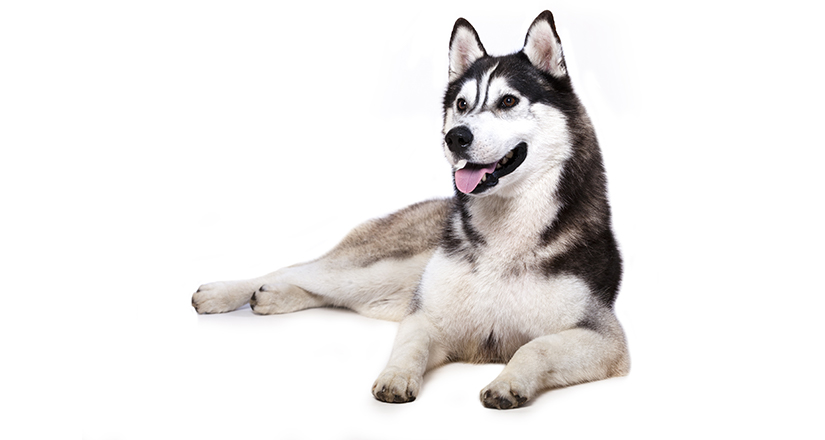The Siberian Husky was believed to have originated by the Chukchi Indians 3000 years ago. The Chukchi population (natives of the Soviet Arctic) of northeast Asia developed this breed. Although the ancestry is unknown, the Siberian Husky comes from spitz stock and evolved hundreds of years ago as a sled pulling dog breed.
The Siberian Husky is part of the AKC Working Group and was recognized by the UKC as the Arctic Husky in 1938. This breed name was changed in 1991 to the Siberian Husky. The Siberian Husky Club (SHCA) consists of a membership of dog breeders, sled dog racing enthusiasts and exhibitors.




Brief History
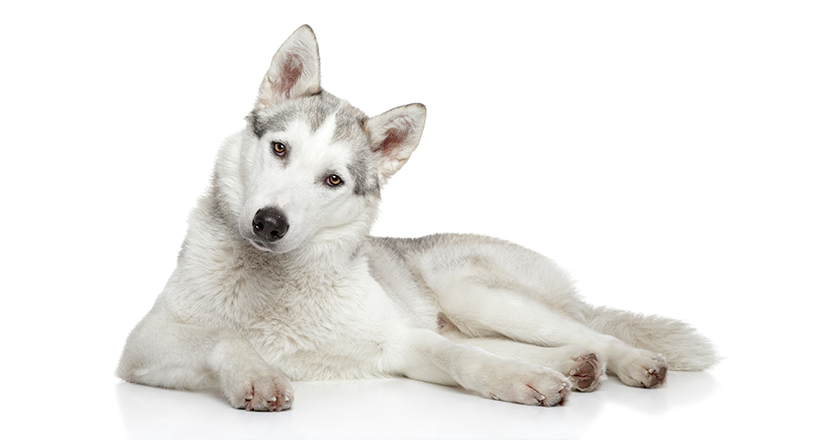
The Siberian Husky, brought by the Indians, traveled across the Bering Straits to Alaska and then went on to Canada and the United States. Siberian Huskies are well-known for their speed, endurance, and excellent temperament.
In 1925 the Siberian Husky raced across 340 miles with serum for diphtheria stricken Nome and saved the town. Today, there is a statue in their honor in Central Park. The AKC recognized this breed in 1930.
The Siberian Husky is a very pure breed because it was kept in isolation until the twentieth century. Alaskans then imported this breed to use for snow sled racing. Today the Alaskan Husky competes in sled racing, and the Siberian Husky remains a loyal companion dog, as well as a recreational sled dog.
The Siberian Husky was also a sled dog for the U.S military and Search & Rescue during World War 2. This breed’s popularity continues to grow today because it is one of the world’s best sled and show dogs. It still is one of the Arctic’s most favorite companion dog breeds.
Physical Description
This is a medium-sized dog breed that is compact and muscular. The Siberian Husky is longer than it is tall. With medium-sized erect ears, this spectacular dog breed is a must for all wolf admirers. The skull is slightly round, and the neck is carried proudly and erect. It is also arched.
The Siberian Husky has almond-shaped eyes that may be brown, blue, one of each, or particolored. With a nose that is either black, liver, flesh-colored, or pink-streaked, depending on the coat color, the Siberian Husky carries a brush tail that proudly displays his Northern heritage. A breed like no other, the Siberian Husky has a very thick coat, is quick and agile, and seems almost effortless in motion.
Temperament
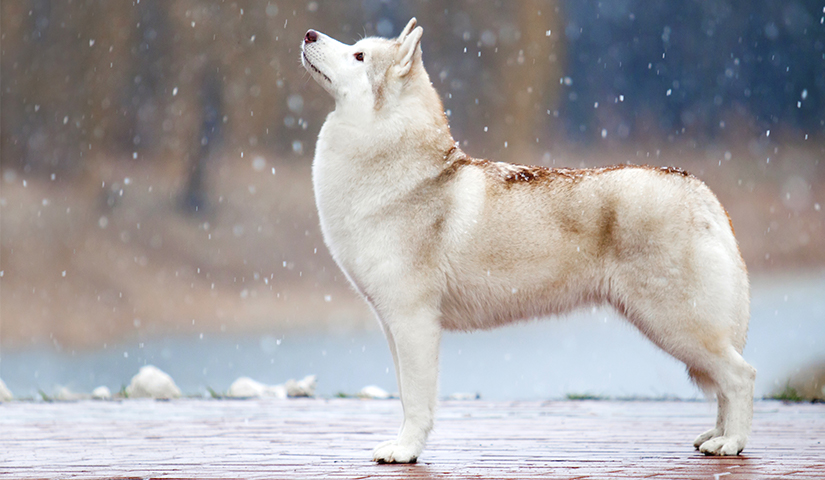
The Siberian Husky is intelligent, friendly, and playful. Although energetic, this very independent breed is terrific to have at home. The Siberian Husky gets along with everyone and is not a one-person dog. This breed is not possessive over one person and is gentle around children and other people. That said, the Siberian Husky is alert and has been known to escape from homes.
Mature Siberian Huskies may be calmer and slightly more reserved around people that they meet. This breed is intelligent, hard-working, and fun-loving and is perfect for an active family. Early puppy socialization with regular positive puppy training classes is a definite must for this feisty, playful dog breed.
The AKC describes this breed as “As born pack dogs, Siberians enjoy family life and get on well with other dogs; their innate friendliness render them indifferent watchdogs. This breed is also energetic and can’t resist chasing small animals, so secure running room is a must. An attractive feature of the breed: Siberians are naturally clean, with little doggy odor.”
Special Needs
The Siberian Husky is an adventurous and alert dog breed that is independent. This majestic breed does well with plenty of off-leash exercises. Early socialization with other dogs, people, and animals is highly recommended.
Puppy training classes for the Siberian Husky is necessary since this breed can only benefit from dog training classes. That said, the Siberian Husky is sensitive yet active and playful.
Positive dog training for the Siberian Husky needs to be consistent. Yet, one needs to consider this breed’s sensitivity and intelligence and not break his playful spirit with unnecessary reprimands. Dog training needs to mold the needs of this beautiful dog breed. Attentive and experienced pet parents are needed for this breed.
Possible Health Concerns
The German Shorthaired Pointer is an incredibly active breed that is intense and enthusiastic in everything it does. Care should be taken during exercise to prevent injury. The German Shorthaired Pointer may be susceptible to the following:
- Cataracts: This occurs when the lens becomes opaque and stops light from reaching the retina. Signs include partial blindness and mild eye issues. Cataracts are often inherited in dog breeds, with other causes being diabetes, radiation, inflammation, trauma, and malnutrition.
- Corneal Dystrophy: this is a hereditary disease that affects the cornea in Siberian Huskies. Dogs with this condition will have small white dots in their cornea. Vision problems are such as hazy vision or opaqueness. There is no treatment for this hereditary disease.
- Hip Dysplasia: This is an abnormal development of the hip joint in large dog breeds like the Siberian Husky. It is generally characterized by a loose joint and then degenerative joint disease. Siberian Huskies s do well on a high-quality diet that is geared towards their life stage. Puppies should only be fed high-quality puppy dog food. Excessive growth, exercise, nutritional factors, and hereditary factors are all critical factors with hip dysplasia. Consult with your veterinarian for expert advice.
- Progressive Retinal Atrophy (PRA) is another common hereditary eye disease in the Siberian Husky. This is an expensive health issue, and early detection is critical to the well-being and vision of your Siberian Husky. PRA can lead to blindness.
The Siberian Husky is an active dog breed that may be susceptible to the following:
Exercise
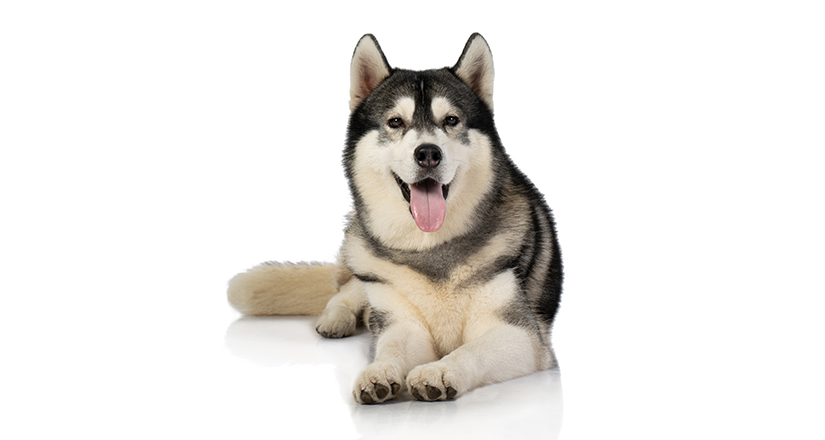
The Siberian Husky almost self-cleans and looks immaculate most of the time. That said, daily grooming is always recommended, along with regular bathing, brushing teeth, ear cleaning, and nail trimming. Visits to the veterinarian are recommended for teeth cleaning twice yearly.
The Siberian Husky has a double coat, consisting of an undercoat and guard hair. Shedding of the undercoat occurs twice a year. It is necessary to take out the “old coat” using a soft brush and metal comb.
Nutrition
Healthy nutrition plays a large role in good health for all dog breeds. Always opt for the very best high-quality dog food that you can afford. Remember that AAFCO requirements don’t allow pet food companies to address a pet’s need for antioxidants. Dogs and all other pets are regularly exposed to free radicals every day, so it’s essential to add antioxidants to neutralize or remove them.
Feed the appropriate food for the life stage of your Siberian Husky. A lower protein (20%) based dog food is recommended during the hot summer months, while in the winter, a higher protein (32%) is recommended.
Every Siberian Husky is different, and a diet that works for one may not work for another. Consult with your veterinarian about the best dog food options for your Siberian Husky. Feeding the correct diet from puppyhood will save you a small fortune in veterinary bills later on.
Grooming
This dog breed is considered a natural dog breed because they’re almost self-cleaning and tend only to need a few baths a year unless they’re showing.
The Siberian Husky almost self-cleans and looks immaculate most of the time. That said, daily grooming is always recommended, along with regular bathing, brushing teeth, ear cleaning, and nail trimming. Visits to the veterinarian are recommended for teeth cleaning twice yearly.
The Siberian Husky has a double coat, consisting of an undercoat and guard hair. Shedding of the undercoat occurs twice a year. It is necessary to take out the “old coat” using a soft brush and metal comb.
Adopting a Siberian Husky
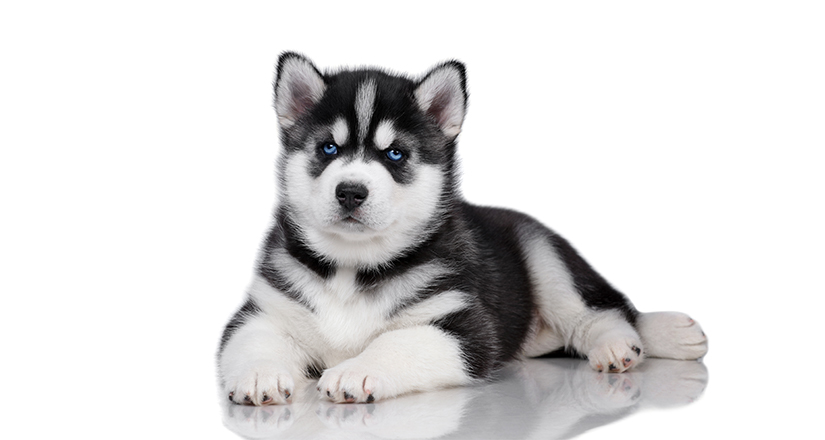
This is a terrific breed to adopt, one that adapts easily to family life and children. The Siberian Husky enjoys having lots of attention and exercise. Active family life is a must, with the Siberian Husky enjoying family trips hiking or to the dog park. This is a dynamic and intelligent dog breed that is happiest when working. Regular exercise and mental stimulation are a must for this dog breed.
The Siberian Husky was bred to run for long distances, so jogging or a long off-leash run every day in a safe area is vital to keep this breed happy, well-behaved and happy. Try out rally, obedience classes, agility, or other dog sports. It may be aggressive toward strange dogs or people, but if socialized during puppyhood will be a generally good companion dog. Some Siberian Huskies howl, dig and chew. Understanding this breed is key to optimizing the happiness and longevity of this breed.
That said, this breed is brilliant and does not do well alone at home all day, most especially during puppyhood. Ensure that you have a fenced yard and that the newly adopted Siberian Husky is well supervised when out and about. This breed is quick to escape.
The Siberian Husky needs to be indoors during the hot summer months, and exercise should occur early morning and late afternoons when cooler. Make sure that this breed does not overheat.
The Siberian Husky is a happy and outgoing dog breed that makes one of the best adoptions in the right environment with expert pet parents. As with any dog adoption, make sure that you have the time and resources to take good care of your Siberian Husky.
